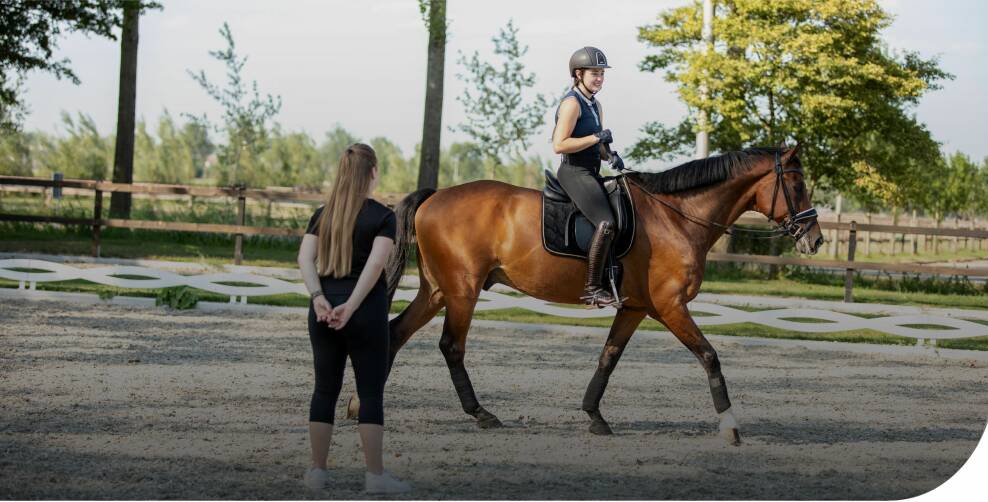Click here!
If you want to work more on your mobility, One Switch has an 8-week training program that also includes a mobility routine. With code MT25 you can get a 25% discount on their Premium Membership, which includes this 8-week program. Click on the button to visit their website for more info!
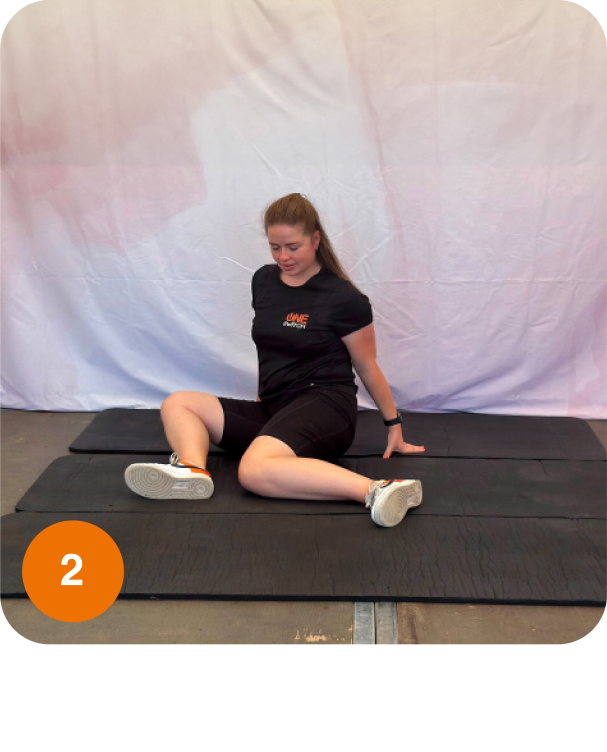

Exercise #3: Hip mobility
exercise
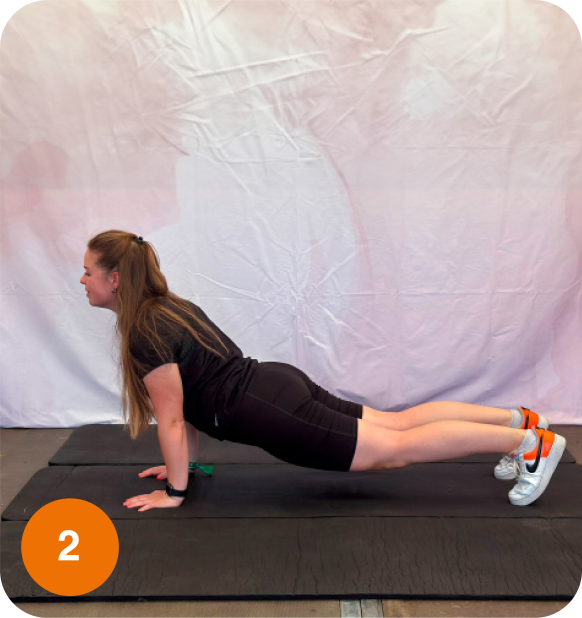
ABOUT ONE SWITCH:
Besides training and planning the programs, the 27 year old Janneke den Otter is also the face of the company, One Switch. She is present in all the photos in this series of eight articles and guides the videos we link to. Janneke has a psychological education as well as a personal trainer degree. She met 36 year old Garry Abbas, a previous professional soccer player and personal trainer, at the gym. Together they are quite an energetic, unique team, who with their experience, education and ability to empathise, provide the best training for any type of horse rider.



Perform the exercise for 30-60 seconds and let gravity do the work, so don’t force yourself into the movement too much.
Hip mobility is an important issue for riders. Limited hip mobility often means the rider is tight in the hip area, which limits the movement in the pelvis of the rider and therefore smooth movement with the horse. Also, a left-right difference indicates that one hip is tighter, which can mean that the rider gives more pressure to the horse with that leg, which can lead to miscommunication and an imbalanced seat.
Hold for at least 10-20 seconds, can also be done dynamically (moving from plank to downward dog repeatedly)
The hamstrings are often tight in riders, especially showjumping and eventing riders, because the angle in their knees is smaller. Stretching the hamstrings and back helps to alleviate tension and maintain or improve flexibility in the dorsal muscle chain. Also, the downward-facing dog helps to improve shoulder mobility and therefore posture as well.
Watch
video
Watch
video
Exercise #2: Downward-facing dog
Hold each side for a minimum of 20-30 seconds
The inner thigh muscles and lower back are often tight in riders. With this stretch, you work on asymmetry in these areas and increase flexibility. This helps to prevent injuries and helps the rider to move more smoothly in the saddle.
Watch
video
Exercise #1:
Adductor stretch + side bend
Better rider mobility may help with:
Improved riding performance: good mobility allows you to move freely and effectively while riding, enabling you to maintain proper posture, balance, and alignment. It helps you maintain a neutral spine, absorb the horse's movement, and communicate more effectively with your horse through subtle aids. Improved mobility also allows you to adapt to different riding disciplines and techniques, such as dressage, jumping or eventing and perform at your best.
Injury prevention: Horse riding can be physically demanding and put a strain on various parts of your body, including the spine, hips, knees and ankles. Poor mobility can lead to imbalances, compensations and increased risk of injuries, such as muscle strains, joint pain or even accidents caused by slower reaction speed. By working on your mobility, you can reduce the risk of injuries, promote better biomechanics and protect yourself from the physical demands of horse riding.
Better horse-rider connection: As a rider, your body is your primary means of communication with your horse. Good mobility allows you to move in harmony with your horse, establish a better connection and communicate more effectively through
subtle aids. It also helps you maintain a stable seat, stay balanced and give clear aids to your horse, resulting in better performance and a more enjoyable riding experience for both you and your horse.
Enhanced rider comfort: Riding requires sitting in the saddle for extended periods of time, which can strain your muscles and joints. Poor mobility can lead to discomfort, pain, and decreased enjoyment of riding. By improving your mobility, you can increase your comfort level in the saddle, reduce muscle tension, and prevent discomfort or pain associated with prolonged sitting and repetitive motions.
Overall fitness and health: Riding is a physically demanding activity that requires strength, flexibility, and endurance. Working on your mobility as a rider can complement your overall fitness routine and contribute to your physical well-being. It can help you build strength, flexibility and stability in the specific areas of your body that are used during riding, leading to improved overall health and fitness levels.
T his time, One Switch is presenting three mobility exercises that could help you as a rider to improve your mobility of the muscles around the hips, spine and shoulder area. It is possible that you might feel differences between left and right. If this is the case, spend a little more time on the side that feels more tight. This helps you to minimize the left-right differences and therefore also improves your symmetry, which is an important factor in developing a more balanced seat and communication with your horse.
By Janneke den Otter. Photos: Malgré Tout & Nicola Hagerman
In order to work optimally with the horse and follow its movements harmoniously and give subtle aids, the rider’s mobility is crucial. That is why mobility is definitely one of the essential rider specific skills that any horse rider should pay attention to. In collaboration with One Switch, we have listed a number of reasons why every rider should work on their mobility.
Malgré Tout has spoken to the renowned Dutch company One Switch who specialises in equestrian vitality. They guide riders to improve their rider specific physical skills, such as mobility, coordination, symmetry, core strength and balance. They work with riders from different disciplines and levels, from recreational to Olympic. Their workouts and trainings are accessible and manageable for every rider no matter discipline and level. This is the second of eight series on rider exercises, helping you become a better training partner for your horse.

ABOUT ONE SWITCH:
Besides training and planning the programs, the 27 year old Janneke den Otter is also the face of the company, One Switch. She is present in all the photos in this series of eight articles and guides the videos we link to. Janneke has a psychological education as well as a personal trainer degree. She met 36 year old Garry Abbas, a previous professional soccer player and personal trainer, at the gym. Together they are quite an energetic, unique team, who with their experience, education and ability to empathise, provide the best training for any type of horse rider.
Click here!
If you want to work more on your mobility, One Switch has an 8-week training program that also includes a mobility routine. With code MT25 you can get a 25% discount on their Premium Membership, which includes this 8-week program. Click on the button to visit their website for more info!
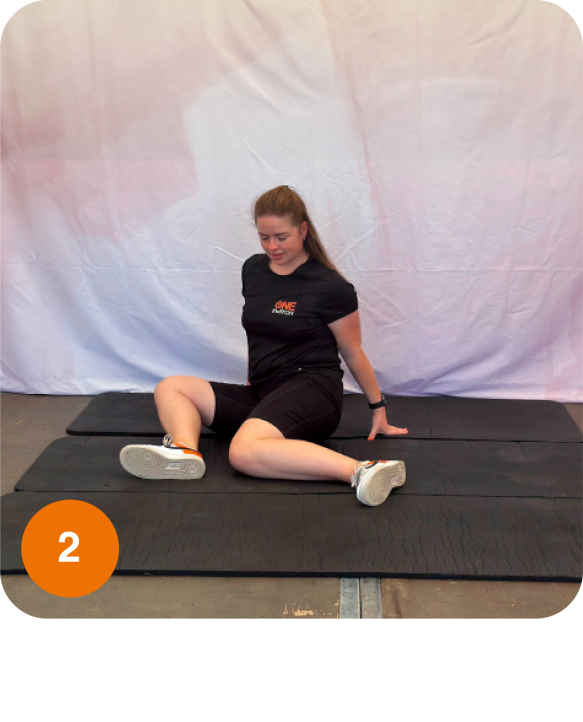
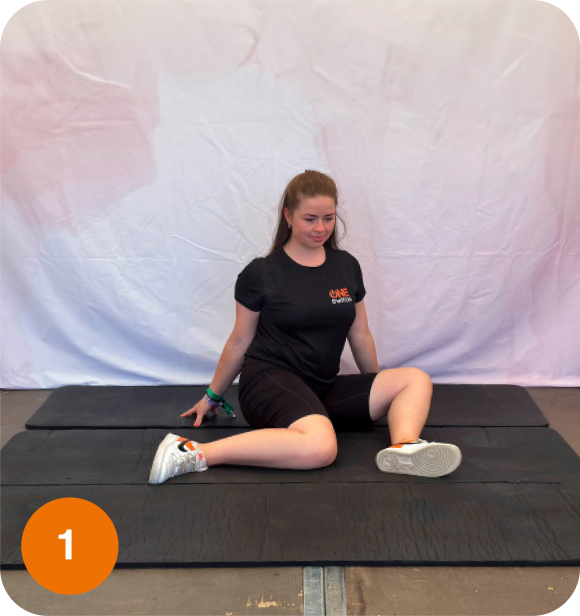
Exercise #3: Hip mobility
exercise
Perform the exercise for 30-60 seconds and let gravity do the work, so don’t force yourself into the movement too much.
Hip mobility is an important issue for riders. Limited hip mobility often means the rider is tight in the hip area, which limits the movement in the pelvis of the rider and therefore smooth movement with the horse. Also, a left-right difference indicates that one hip is tighter, which can mean that the rider gives more pressure to the horse with that leg, which can lead to miscommunication and an imbalanced seat.
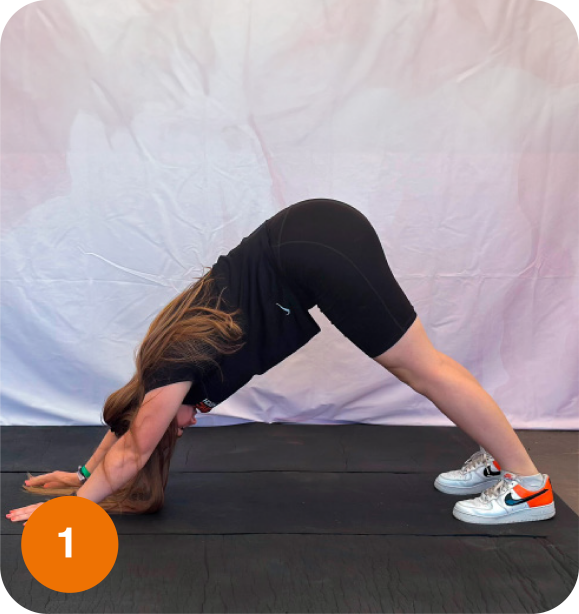
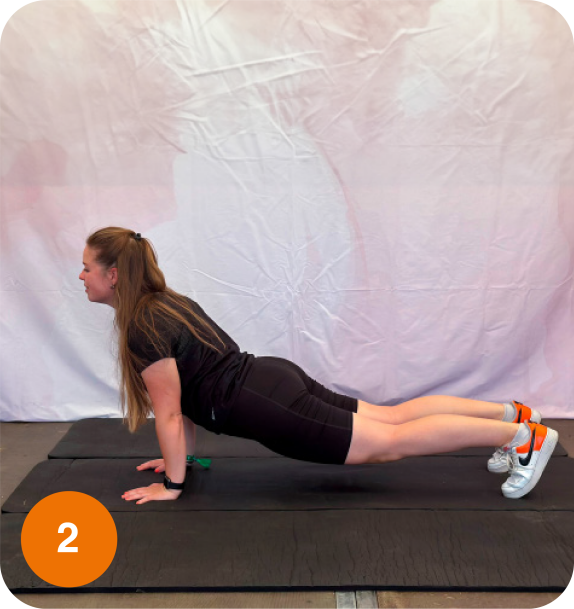
Hold for at least 10-20 seconds, can also be done dynamically (moving from plank to downward dog repeatedly)
The hamstrings are often tight in riders, especially showjumping and eventing riders, because the angle in their knees is smaller. Stretching the hamstrings and back helps to alleviate tension and maintain or improve flexibility in the dorsal muscle chain. Also, the downward-facing dog helps to improve shoulder mobility and therefore posture as well.
Watch
video
Exercise #2: Downward-facing dog

Hold each side for a minimum of 20-30 seconds
The inner thigh muscles and lower back are often tight in riders. With this stretch, you work on asymmetry in these areas and increase flexibility. This helps to prevent injuries and helps the rider to move more smoothly in the saddle.

Exercise #1:
Adductor stretch + side bend
Better rider mobility may help with:
Improved riding performance: good mobility allows you to move freely and effectively while riding, enabling you to maintain proper posture, balance, and alignment. It helps you maintain a neutral spine, absorb the horse's movement, and communicate more effectively with your horse through subtle aids. Improved mobility also allows you to adapt to different riding disciplines and techniques, such as dressage, jumping or eventing and perform at your best.
Injury prevention: Horse riding can be physically demanding and put a strain on various parts of your body, including the spine, hips, knees and ankles. Poor mobility can lead to imbalances, compensations and increased risk of injuries, such as muscle strains, joint pain or even accidents caused by slower reaction speed. By working on your mobility, you can reduce the risk of injuries, promote better biomechanics and protect yourself from the physical demands of horse riding.
Better horse-rider connection: As a rider, your body is your primary means of communication with your horse. Good mobility allows you to move in harmony with your horse, establish a better connection and communicate more effectively through subtle aids. It also helps you maintain a stable seat, stay balanced and give clear aids to your horse, resulting in better performance and a more enjoyable riding experience for both you and your horse.
Enhanced rider comfort: Riding requires sitting in the saddle for extended periods of time, which can strain your muscles and joints. Poor mobility can lead to discomfort, pain, and decreased enjoyment of riding. By improving your mobility, you can increase your comfort level in the saddle, reduce muscle tension, and prevent discomfort or pain associated with prolonged sitting and repetitive motions.
Overall fitness and health: Riding is a physically demanding activity that requires strength, flexibility, and endurance. Working on your mobility as a rider can complement your overall fitness routine and contribute to your physical well-being. It can help you build strength, flexibility and stability in the specific areas of your body that are used during riding, leading to improved overall health and fitness levels.
Malgré Tout has spoken to the renowned Dutch company One Switch who specialises in equestrian vitality. They guide riders to improve their rider specific physical skills, such as mobility, coordination, symmetry, core strength and balance. They work with riders from different disciplines and levels, from recreational to Olympic. Their workouts and trainings are accessible and manageable for every rider no matter discipline and level. This is the second of eight series on rider exercises, helping you become a better training partner for your horse.
By Janneke den Otter. Photos: Malgré Tout & Nicola Hagerman
In order to work optimally with the horse and follow its movements harmoniously and give subtle aids, the rider’s mobility is crucial. That is why mobility is definitely one of the essential rider specific skills that any horse rider should pay attention to. In collaboration with One Switch, we have listed a number of reasons why every rider should work on their mobility.
T his time, One Switch is presenting three mobility exercises that could help you as a rider to improve your mobility of the muscles around the hips, spine and shoulder area. It is possible that you might feel differences between left and right. If this is the case, spend a little more time on the side that feels more tight. This helps you to minimize the left-right differences and therefore also improves your symmetry, which is an important factor in developing a more balanced seat and communication with your horse.
